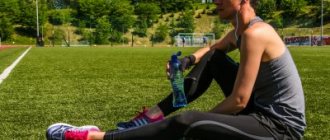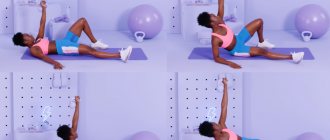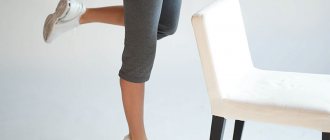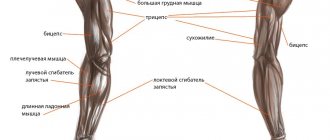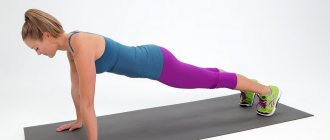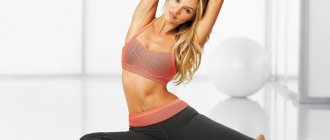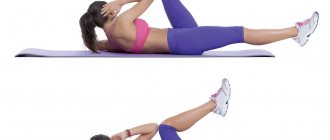2. Bow. Exercises for the abdomen, buttocks, legs
Article on the topic Volumetrics - a new nutrition system that will help you lose weight Stand up as for the previous exercise. Place one leg slightly forward and on your toes, straining your calf and lower leg. At the same time, lower your head to your chest, slouch your shoulders, forcefully draw in your stomach and wrap your arms around it so that you hug your sides with your palms. Now stretch your arms forward, raising your head, and return to the starting position. Do 5-6 times on each leg. You can repeat exercises 2 and 3 again, and then move on.
What exercises to choose to maintain your figure?
If you want to stay in shape after quitting the gym, focus on basic strength exercises using your own weight, shock absorbers and dumbbells. We asked Diana Ibragimova to compose and show us a set of exercises to maintain a figure . “This is basic strength training, it helps strengthen the main muscle groups - arms, legs, abs, the things that usually interest us. This is necessary for good health and metabolism, for visual shape,” says Diana Ibragimova.
A separate plus is that it can be performed at home .
Side Lunges
Exercise for the buttocks, inner thighs, riding breeches and abs
Stand straight, feet shoulder-width apart, feet parallel, hands on your waist. Squeeze your shoulder blades and pull your stomach in, maintain this position throughout the entire exercise. Take a wide step to the side on your heel, making sure that your foot is again parallel to the supporting one. Squat down, moving your pelvis back slightly and tilting your body, but without rounding your back. Straighten up, put your foot down and repeat the same on the other side.
Do 20 lunges in each direction, 2-3 sets.
The use of physical exercises to form a beautiful figure
. The training intensity is not what you need
Answer this question honestly: do you give 100 percent in the gym?
Sometimes people go to two extremes:
. Afraid of overtraining, some finish the training process too early, without receiving the load necessary for a high-quality result;
. On the contrary, they train according to the principle “the more intense, the greater the load, the better.”
Both are wrong.
Let's consider the first option.
If you still don’t know, then know that as a result of intense training, so-called lactic acid accumulates in the muscles, which causes unpleasant and sometimes quite painful sensations in the muscle group on which the exercises were done. And this is not bad! Don’t be afraid of this feeling and run away from the gym for a week. On the contrary: if you feel pain, know that everything is OK, the process has begun. This means that your body is not yet accustomed to such a load; it is new to it. And this is one of the main goals of training, to constantly present surprises to your body and not let it relax.
So don’t be afraid to increase the number of approaches and repetitions, experiment with weights, gradually making them heavier - you need to overcome yourself! And the results will begin to gradually come during the recovery period: a body that has been thoroughly exhausted during training will take on a new shape and increase muscle volume.
However, the above aspirations, while certainly very useful and necessary, should not develop into the second extreme - fanaticism.
In other words, you need to be able to very clearly feel the line beyond which the sensations from good intense training simply go beyond the state of overtraining of the body. But this is no longer any good. Enthusiasm is good, but you shouldn’t lose your head in pursuit of results either. You know roughly your strengths; you don’t need to rely on the intensity of the training of professionals who have been training for several years.
For example, not everyone can withstand two days in a row of intense training in the gym - and for you this is most likely too much. Five exercises per workout, with a maximum number of approaches - four to five times - is also already the ceiling; anything that exceeds this norm is hardly beneficial. On the contrary: by overloading your body, you risk not only not increasing in size, but also losing muscle mass.
Conclusion: you need to train intensively, but wisely.
. You have chosen the wrong set of exercises for yourself
Yes, yes, this is a very common mistake. And no amount of intensity will help if you are doing something that has nothing to do with muscle growth. Well, or it does, but not to the required extent. After all, what exercises are primarily necessary for a qualitative increase in muscle volume? Basically, these are basic exercises that involve working with a barbell or dumbbells. Of course, they are more difficult to perform than training on simulators or block machines, but they bring a much more tangible effect. Unfortunately, many people ignore this fact and stubbornly try to achieve success by reducing basic exercises to a minimum, or even eliminating them altogether. And after that you ask, where is the result?
Conclusion: in order to get results from training, you need to perform those exercises that bring the main result. That is, the basic ones.
. You're not eating right
Finding out whether your nutrition process is organized correctly is not difficult. Do you eat irregularly, eat fatty, high-calorie foods, do you like sweets? Then start improving.
No, of course you need calories, because in order for muscle mass to grow, you need to give it building material for this. But! The products through which this process will occur must be healthy and dietary, containing a high percentage of substances that provide nutrition and muscle growth. And the process of eating should be divided into stages, at intervals of approximately two to three hours throughout the day.
So, remember that every kilogram of your weight needs to be provided daily with about two grams of protein, plus about another forty kilocalories there.
Conclusion: down with cakes and chocolates! Long live the diet, that is, proper, balanced nutrition!
. You don't get enough sleep
But in vain, because sleep is a very important process during which the body recovers most effectively, so you should not neglect it.
In principle, an ordinary person gets enough sleep in six to eight hours, while fully regaining his strength. However, for those who are intensely involved in fitness, things happen a little differently. An organism that is constantly subjected to intense training naturally experiences considerable stress: both the muscles and the lymphatic systems are stressed, and the nervous system is not left out. So sleep more! This is for the good. If possible, sleep for an hour another day. If not, in any case, plan your day so that you get eight to nine hours of sleep - and that’s a minimum!
Conclusion: sleep is the best recovery for the body, do not neglect it.
. Do you drink? Do you smoke?
Then quit. No, really: at least it’s worth reducing the dose. Now we don’t want to lecture you at all about the dangers of alcohol and nicotine, however, you must agree, training with a hangover is a thankless task. Well, there’s no need to talk about the ability of the respiratory system to withstand stress after smoking one or two packs of cigarettes a day. And the liver, which occupies an important place in the process of synthesis of muscle tissue, is so easily destroyed by large amounts of alcoholic beverages! How does the cardiovascular system suffer? To what extent is the body's endurance lost? Have you ever thought about it? For sure. Think again and draw the appropriate conclusions. And stop making excuses that nicotine reduces appetite; you won’t care, most likely, you’ll need to build your nutrition system from scratch.
Conclusion: lead an exceptionally healthy lifestyle, stay away from alcohol and nicotine!
Conclusion
IMPROVING THE NERVOUS SYSTEM
By engaging in physical education, we acquire the motor skills necessary in everyday life and at work. The dexterity, speed and strength of our body movements develops. The control of movements, which is carried out by the central nervous system, is improved. When doing physical exercises, more and more new conditioned reflexes are formed, which are fixed and formed in long consecutive rows. Thanks to this, the body acquires the ability to better and better adapt to greater and more complex physical activity, thanks to this we can carry out movements more easily and more economically - our body, as they say, trains.
As a result of training, the work and structure of all organs of our body, and especially the higher parts of the central nervous system, improves. The mobility of the nervous processes of excitation and inhibition in the cerebral cortex and in other parts of the nervous system increases, i.e., the process of excitation more easily transforms into the process of inhibition and vice versa. The body therefore reacts more quickly to all kinds of external and internal irritations, including irritations coming to the brain from contracting muscles, as a result of which body movements become faster and more dexterous.
In trained people, the nervous system more easily adapts to new movements and new operating conditions of the motor system.
MUSCLE VOLUME AND STRENGTH INCREASES
During physical exercise, the strength of excitation and inhibition processes in the cerebral cortex increases, resulting in increased muscle tension during contraction. In this regard, the structure of muscle fibers changes - they become thicker, muscle volume increases. By systematically doing so-called strength exercises, for example with weights, you can dramatically increase muscle volume and strength in 6-8 months.
This happens because the nutrition of the working muscles is significantly improved. In muscles at rest, most of the blood capillaries surrounding the muscle fibers are closed to blood flow, and blood does not flow through them. During work, when the muscle contracts, all capillaries open, so the blood flow into the muscle increases more than 30 times. During training, new blood capillaries are formed in the muscles.
Under the influence of training, the chemical composition of the muscle also changes. It increases the amount of so-called energetic substances, i.e. substances, the decay of which releases a lot of energy. These substances include glycogen and phosphagen. In trained muscles, glycogen and phosphorus compounds, which break down during contractions of muscle fibers, are restored faster, and oxidative processes (processes of combining with oxygen) proceed more intensely, muscle tissue absorbs oxygen better and uses it better.
STRONG POSTURE IS MAINTAINED
Training has a beneficial effect not only on the muscles. The entire musculoskeletal system is strengthened, bones, ligaments, and tendons become stronger. Systematic physical exercise significantly affects the external shape of the body, contributes to its proportional development in childhood and adolescence, and in adulthood and old age allows you to maintain beauty and slimness for a long time.
On the contrary, a sedentary lifestyle prematurely ages a person. He becomes flabby, his stomach sags, and his posture sharply worsens. Typically, a person who is not involved in physical labor and sports is slouched, his head is tilted forward, his back is hunched, his lower back is excessively arched, his chest is sunken, and his stomach protrudes forward due to weakness of the abdominal muscles, even if there is no obesity (and it very often develops in those who move little and do not engage in physical education.
Physical exercises that strengthen the muscles (especially the muscles of the trunk) can correct your posture. For this purpose, it is useful to do gymnastics and swim - breaststroke is best; Correct posture is facilitated by a horizontal position of the body and uniform exercise of numerous muscle groups.
With specially selected physical exercises, you can eliminate lateral curvatures of the spine in the initial stage of development, strengthen the abdominal muscles weakened by inactivity or long-term illness, and strengthen and restore the arches of the feet with flat feet. Vigorous exercise and diet can help you fight crippling obesity.
Physical exercises that correct physique defects must be used according to the instructions and under the supervision of a medical specialist.
HEART WORK IMPROVES
A trained person becomes more resilient, he can perform more intense movements and perform heavy muscular work for a long time. This largely depends on his circulatory, respiratory and excretory organs working better. Their ability to sharply intensify their work and adapt it to the conditions created in the body during increased physical activity increases significantly.
Hard-working muscles require more oxygen and nutrients, as well as faster removal of metabolic waste products. Both are achieved due to the fact that more blood flows into the muscles and the speed of blood flow in the blood vessels increases. In addition, the blood in the lungs is more saturated with oxygen. All this is possible only because the work of the heart and lungs is significantly enhanced.
When we are at rest, the heart pumps about 5 liters of blood into the aorta per minute. During intense physical stress, for example, while running or overcoming an obstacle course, etc., the pulse increases from 60-70 to 120-200 beats per minute, the amount of blood ejected by the heart in 1 minute increases to 10-20 and even 40 liters . Blood pressure in the arteries increases from 120 to 200 mmHg.
In trained people, the heart adapts more easily to new working conditions, and after finishing physical exercise it returns to normal activity more quickly. The number of contractions of a trained heart is smaller, and therefore the pulse is less frequent, but with each contraction the heart releases more blood into the arteries.
With rarer heart contractions, more favorable conditions are created for the heart muscle to rest. As a result of training, the work of the heart and blood vessels becomes more economical and is better regulated by the nervous system.
BREATHING BECOMES DEEPER
At rest, a person makes about 16 respiratory movements per minute. With each breath, about 500 cm3 of air enters the lungs.
During physical activity, due to increased oxygen consumption by the muscles, breathing becomes more frequent and deeper. The volume of pulmonary ventilation, i.e., the amount of air passing through the lungs in one minute, increases sharply - from 8 liters at rest to 100-140 liters during fast running, swimming, or skiing. And the more air passes through the lungs, the more oxygen the body receives.
At rest, a person absorbs about 0.2 liters of oxygen per minute. During muscular work, the amount of oxygen absorbed increases, but within certain limits. The greatest amount of oxygen absorption, the so-called oxygen ceiling, is not so great for untrained people, it is equal to 2-3.5 liters, and in well-trained people the body can receive 5-5.5 liters of oxygen per minute through the lungs. Therefore, during physical work, trained people do not develop an “oxygen debt” so quickly (this is the name of the difference between the need for oxygen and its actual consumption) and they better mobilize the adaptive capabilities of breathing and blood circulation. This is clearly visible, for example, when measuring the vital capacity of the lungs with a spirometer.
Plank
To perform the exercise, just get into a push-up position on straight legs. This exercise perfectly strengthens all the muscles of the body, working the abs, legs, back muscles, arms, and internal abdominal muscles. The plank is performed for a while; the first time you do it, you need to set a timer, hold for the maximum possible number of seconds and increase it by 10 seconds each time. If you perform the exercise regularly, you can achieve results not only in 1-2 minutes, but also in 5 minutes. Staying fit with this exercise is not easy, but the results are worth the effort.
bar
Taking the leg to the side
Exercise for the buttocks, riding breeches and waist
Get on your elbows and knees. Raise your left knee: the leg is bent at approximately a right angle, the thigh is approximately parallel to the floor. Throughout the exercise, try not to lower your hip below this level. Pull your knee to your left shoulder from the side (most likely you won’t be able to reach it, but this is the direction of movement) and return it to the starting position with weight behind you. Do not place your knee on the floor until the end of the repetitions!
Repeat 20 times and switch legs, 2 sets.
Photo: AiF/Eduard Kudryavitsky
Mahi
The exercise can be performed from a standing position or lying on your side. One leg is in support, the other is moved to the side and as high as possible. Hands on the waist, back straight, number of repetitions on each leg - 20. The exercise also uses the oblique abdominal muscles. Swings not only help to work and strengthen the muscles of the legs, but also help improve flexibility, which also plays an important role in maintaining a beautiful shape. If doing 20 reps doesn't make your muscles tense, increase the number until you feel a burning sensation.
swings

